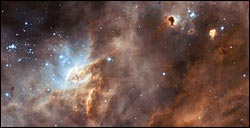This area deals with the fundamental laws and building blocks of nature and how they interact, the properties and the behavior of matter, and research into space and time and their structures.
innovations-report provides in-depth reports and articles on subjects such as astrophysics, laser technologies, nuclear, quantum, particle and solid-state physics, nanotechnologies, planetary research and findings (Mars, Venus) and developments related to the Hubble Telescope.

The world’s largest scale model of the Solar System will be created in the UK thanks to an award of £28,000 from NESTA (the National Endowment for Science, Technology & the Arts), the organisation that invests in UK creativity and innovation. The project, run by Spaced Out UK, will be made with 18 UK schools and visitor attractions and bring together artists, scientist and designers in raising the profile of astronomy and creating an exciting new learning resource for the nation.
In all, th

In the future, our computers no longer crash as we try and download pictures that are too heavy in memory, our cars no longer pollute the atmosphere and cancer could be dealt with by a visit to the GP. Some of it, at least, will happen thanks to cutting edge research happening now at the University of Leicester Department of Physics and Astronomy.
Here scientists are among a handful across the world helping to turn science fiction into a fact of the future through the science of nanotechnol

Finland has become the eleventh member state of the European Southern Observatory (ESO) [1].
The formal accession procedure was carried through as planned and has now been completed. Following the signing of the corresponding Agreement earlier this year (ESO PR 02/04), acceptance by the Finnish Parliament and ratification by the Finnish President of the Agreement as well as the ESO Convention and the associated protocols in June [2] and the deposit of the instruments of accession tod

The NASA/ESA Hubble Space Telescope captures the iridescent tapestry of star birth in a neighbouring galaxy in this panoramic view of glowing gas, dark dust clouds, and young, hot stars. The star-forming region, catalogued as N11B lies in the Large Magellanic Cloud (LMC), located only 160,000 light-years from Earth. With its high resolution, the Hubble Space Telescope is able to view details of star formation in the LMC as easily as ground-based telescopes are able to observe stellar formation withi

After a seven-year cruise through the Solar System, the joint NASA/ESA/ASI Cassini-Huygens spacecraft last night successfully entered orbit around Saturn. The Cassini orbiter is now ready to begin its four-year survey of the planet and its moons, while the Huygens probe will be prepared for the next major mission milestone: its release toward the largest moon, Titan, in December.
“This shows international space co-operation at its best,” said ESA’s Director of Science, Prof. David Southwood

UK scientists involved in the Cassini space mission were ‘over the Moon’ after the spacecraft’s 100,000 km per hour white knuckle ride courtesy of Saturn’s gravity which successfully completed the critical manoeuvre to place Cassini in orbit around the ringed planet. ‘I’ve waited 15 years for this moment,’ said Dr Andrew Coates of the UK’s Mullard Space Science Laboratory and Co-Investigator on the Cassini spacecraft’s Plasma Electron Spectrometer,’ and now our 4-year tour of discovery can really be